by Chuck Cravens
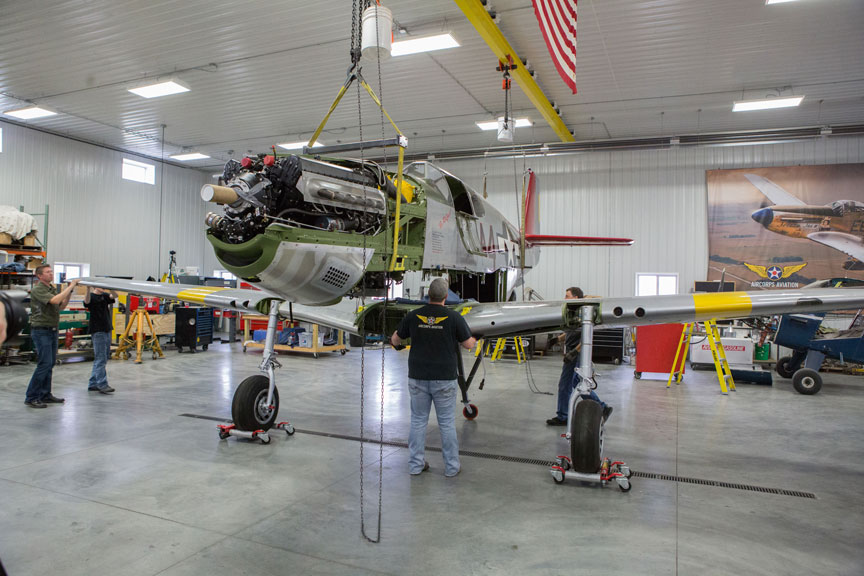
Lining up the wing and fuselage, almost ready to join.
Update
Some very significant events have happened this last month.
Many assume our restoration shop is at the airport but that isn’t the case. It is 8 miles away in an industrial park.
So, along with the usual restoration shop images, we have a section showing the move of the fuselage from the restoration shop out to our hangar at the Bemidji airport on Tuesday, September 13th. The trip on a flat bed was 8.3 miles and took about 30 minutes to complete. It is always fun to watch the faces of other drivers when they see such an unexpected sight as a WWII fighter going by on a flatbed trailer!
A week later the wings arrived from Odegaard Wings, so the time to mate the wings and fuselage couldn’t be too far off.
In fact the reinstallation of the wing was done on Tuesday October 4th, earlier than we expected.
We’ll save those events for later in the update. First we will show some of the fabrication and restoration work that lead up to them.
Header Tank
Mustang coolant header tanks aren’t an easy part to make. They must be made precisely to the original North American drawings and specifications and then be strenuously pressure tested.
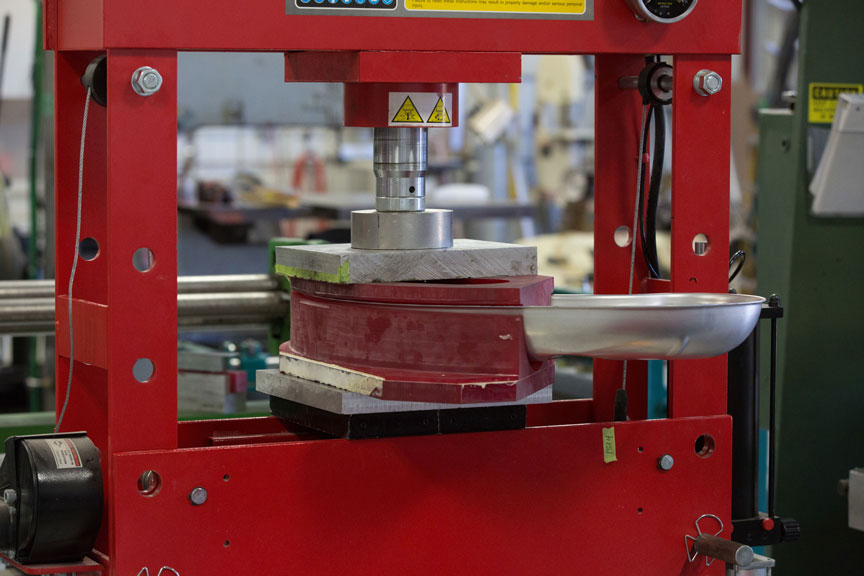
Here we see part of the Red Tail’s new header tank fabrication work.
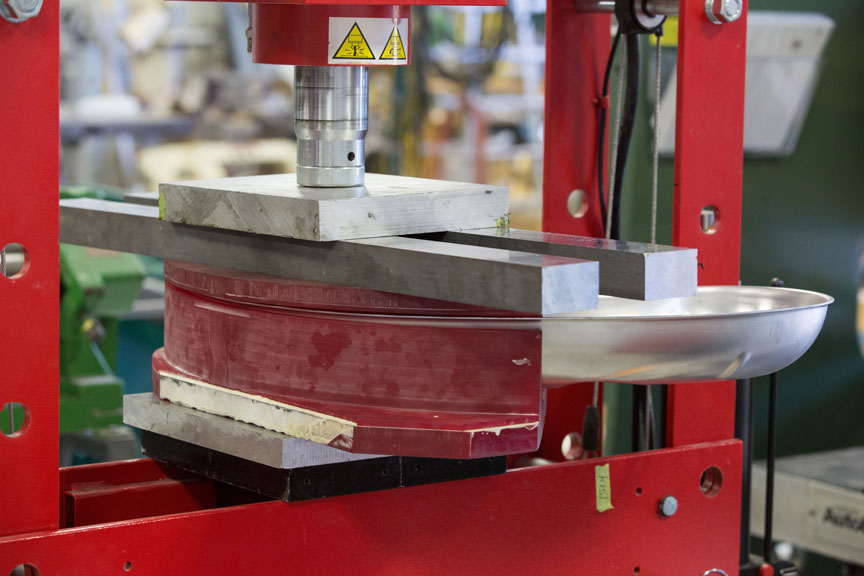
Another view of trueing up the header tank half; here added cross bracing has been put in place to spread the press load.
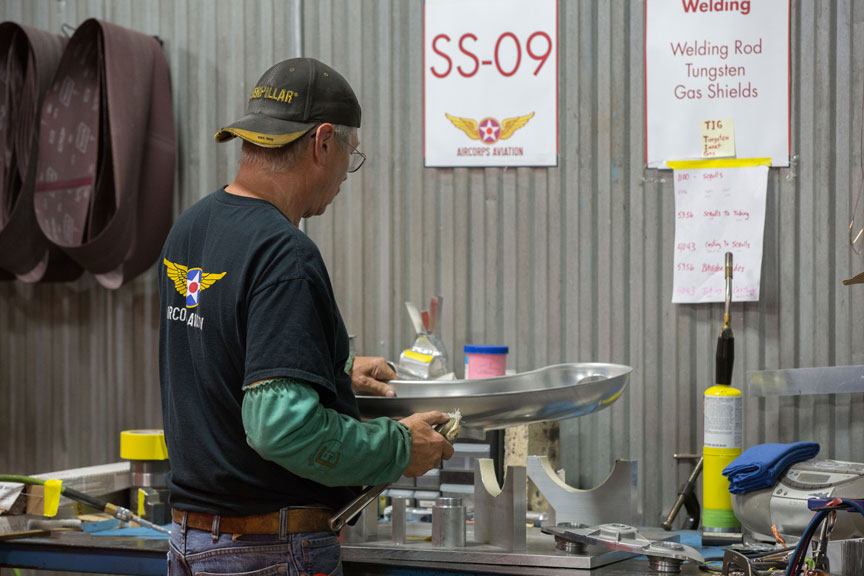
Mike is placing the header tank half into the welding fixture.
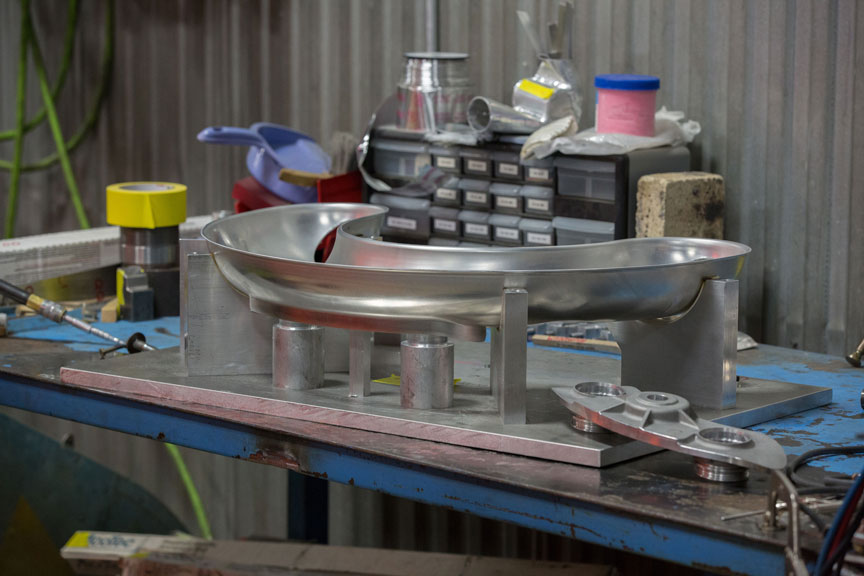
Half of the Red Tail’s newly trued header tank sitting in the welding fixture.
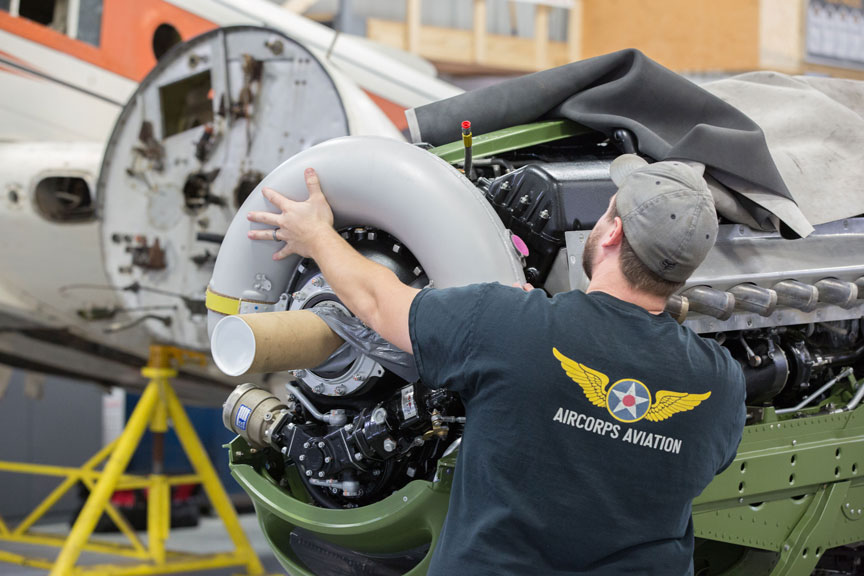
Tye test fits the completed tank.
The process of stamping an indentation for the crankcase breather clearance into the tank half introduces some distortion. That distortion must be taken out of the tank half before moving on to welding.
Cooling Induction and Exhaust
We’ve seen many pictures of the scoop, doghouse and exit door. That is because an awful lot of work is necessary to complete this complex area on a P-51. The scoop goes on after the wing and fuselage are mated.
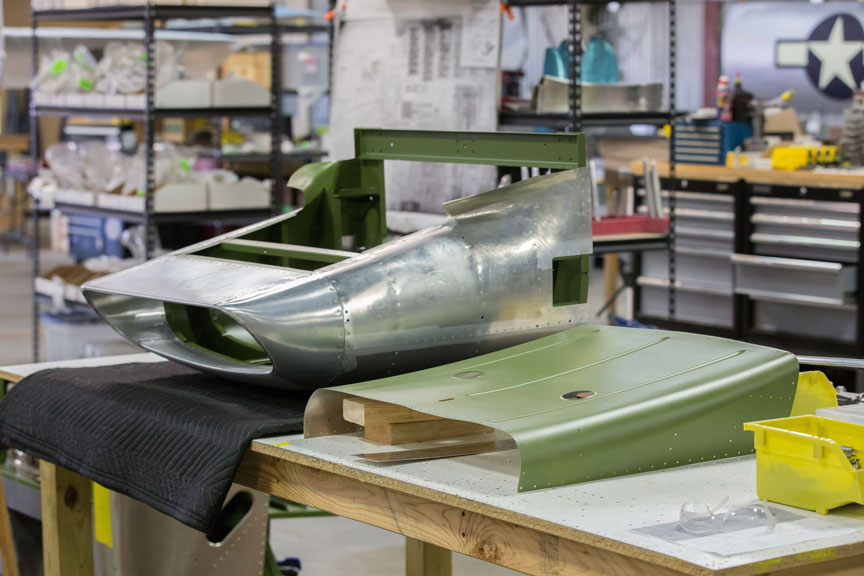
The Red Tail’s scoop with a section of its upper skin ready to go on sit on a bench.
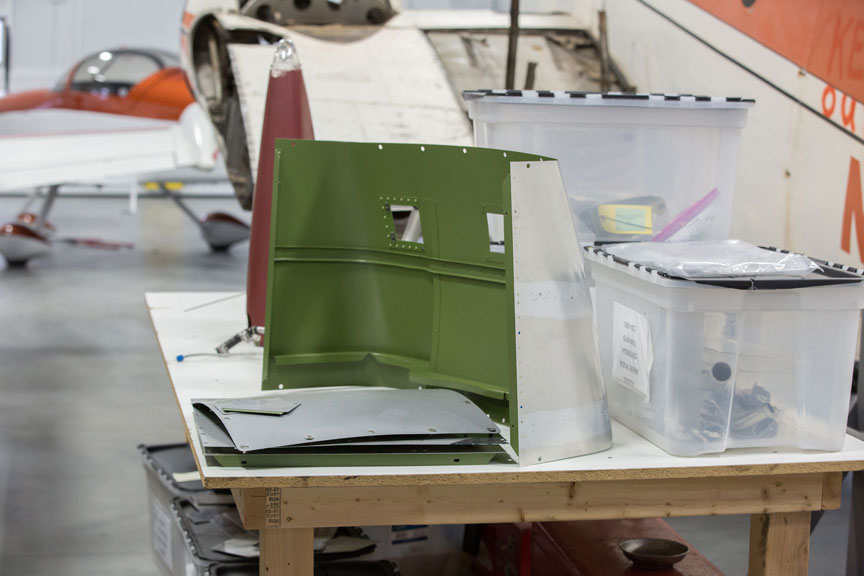
he radiator wrapper skin fairs the radiator area into the doghouse.

In this view, the oil cooler exit door is visible at the bottom of the scoop.
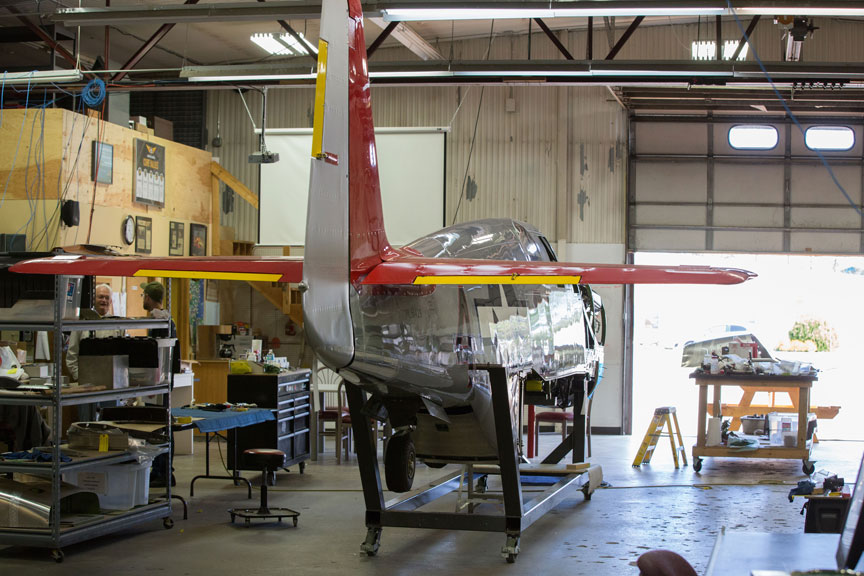
In this rear view of how Tuskegee Airmen looks in the fuselage fixture, the radiator and rear part of the cooling system air ducting is permanently in place.
Firewall Forward
Early this month, fabrication and fitting of the final sheet metal skin pieces and finishing the engine systems were the order of the day.
Another job was removing the nickel plating on the prop blades. The supply of P-51 propeller blades is becoming smaller and smaller, so they are difficult to acquire and very expensive. There is an STC ( Supplemental Type Certificate) that allows the use of Grumman Albatross blades on P-51s. Due to the expense and limited availability of P-51 blades, the Red Tail takes advantage of that STC and uses these blades.
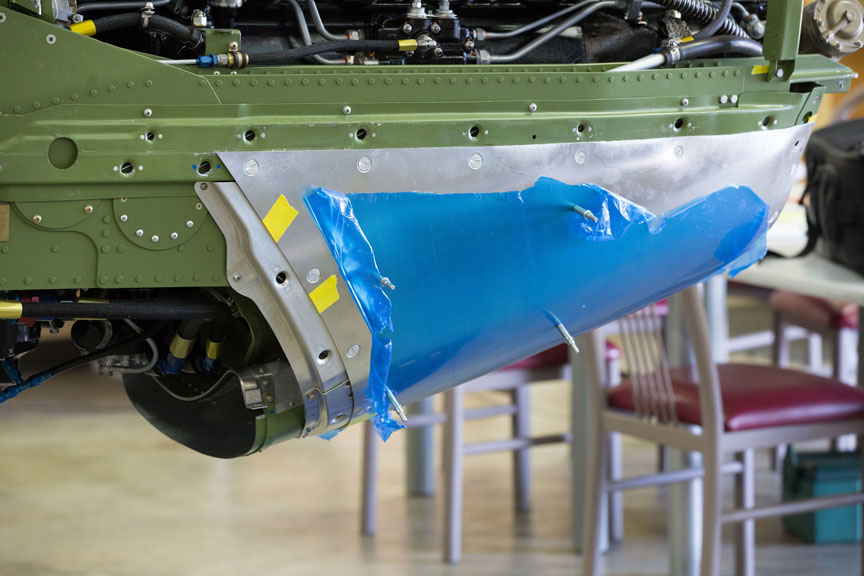
The chin cowl Dzus fittings are finished
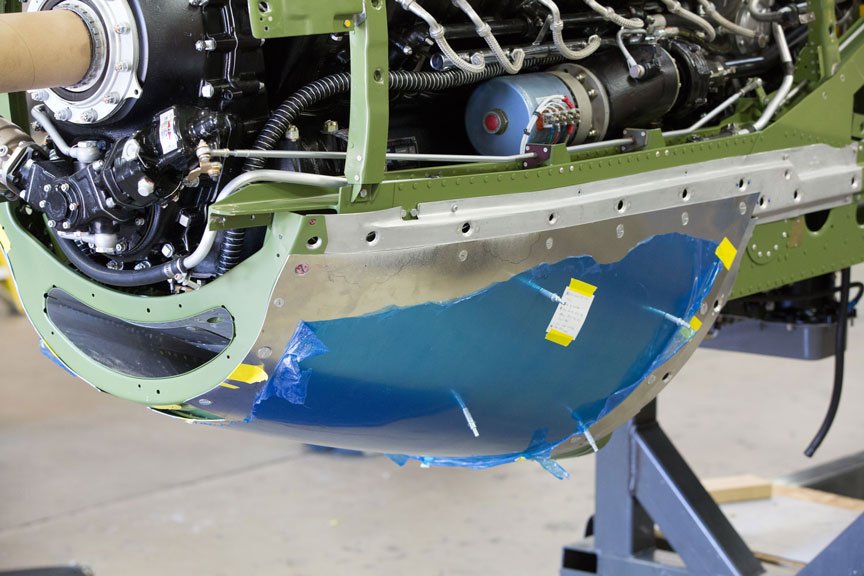
Another angle shows the other side of the chin cowl.
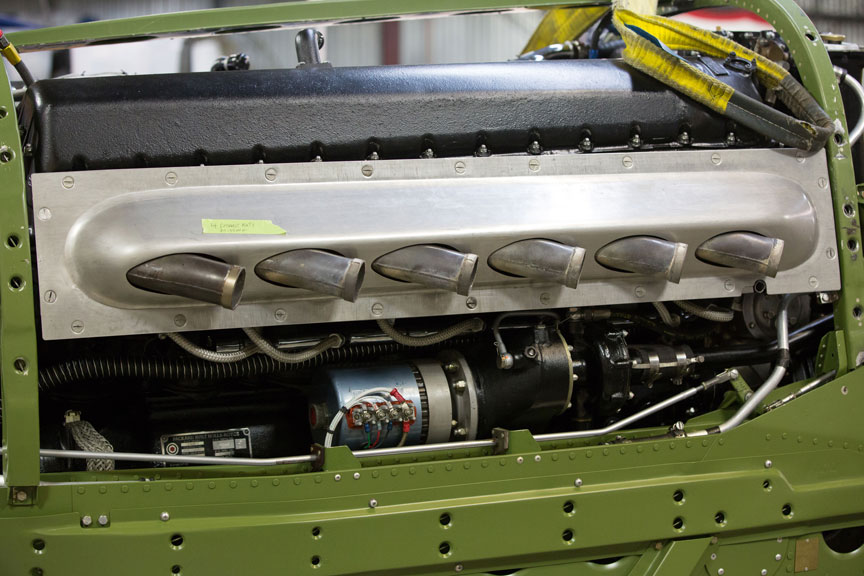
The replacement stainless steel exhaust shroud is in place.
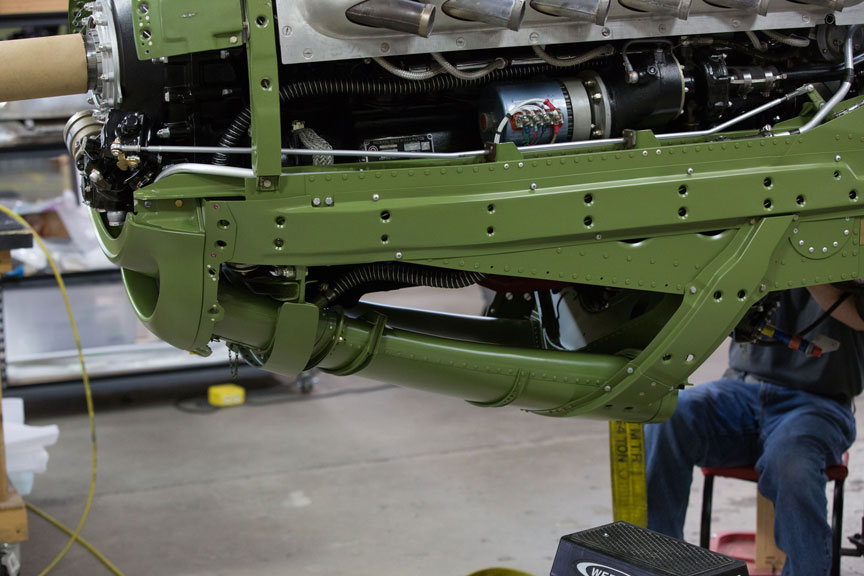
The “smile” is painted and installed permanently.
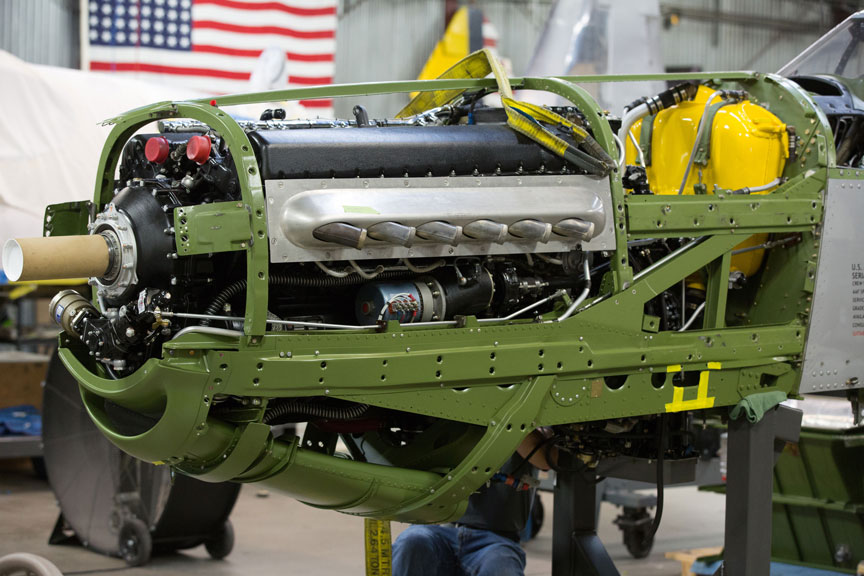
The engine systems are nearing completion.
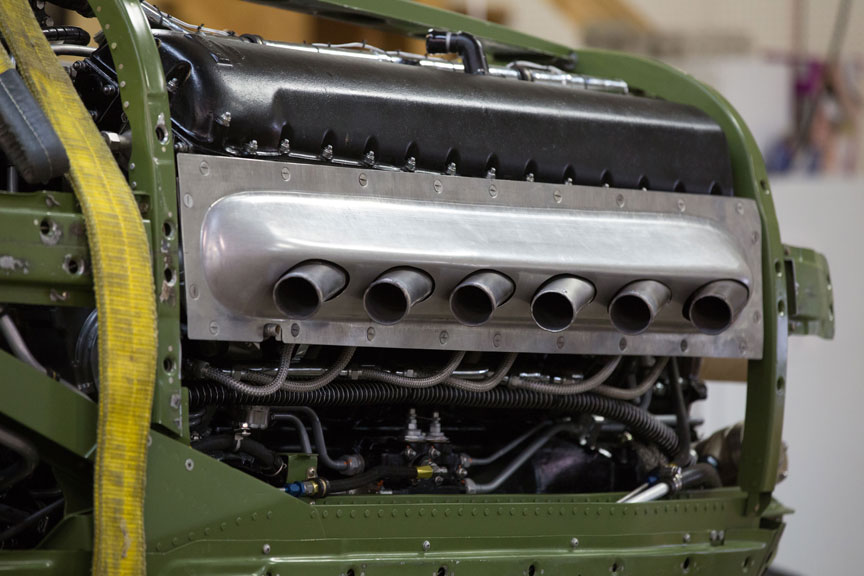
A rear view of the exhaust stacks and shroud show up in this image
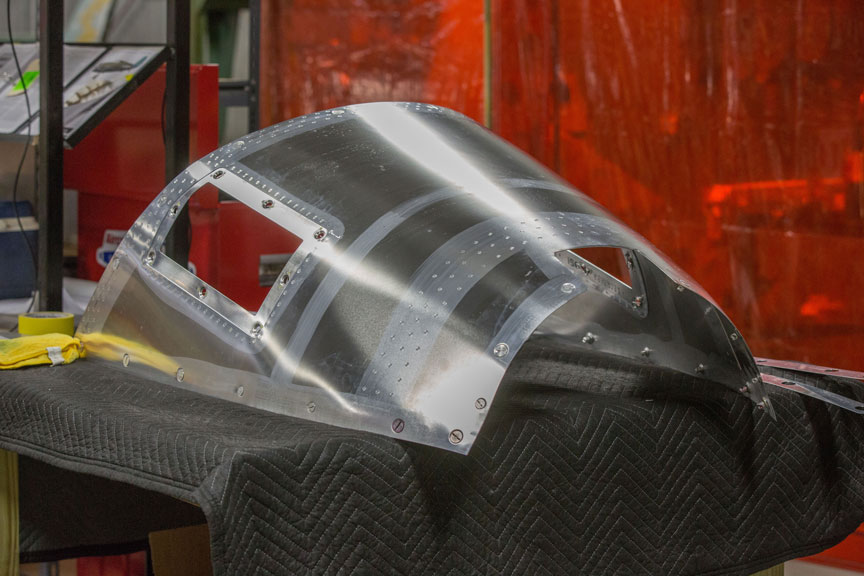
Forward lower cowl with the reinforcements for the air filter box covers in place
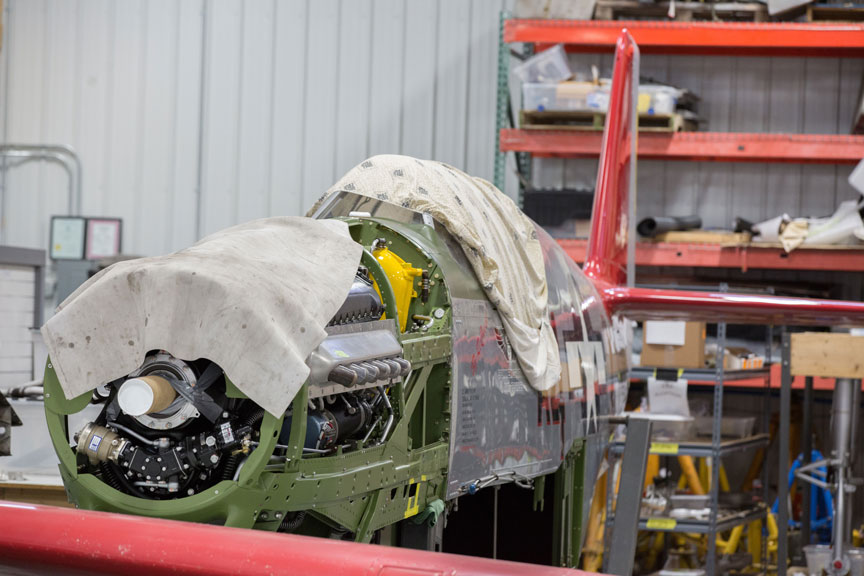
The Red Tail, nearly ready to move out to the airport hangar.
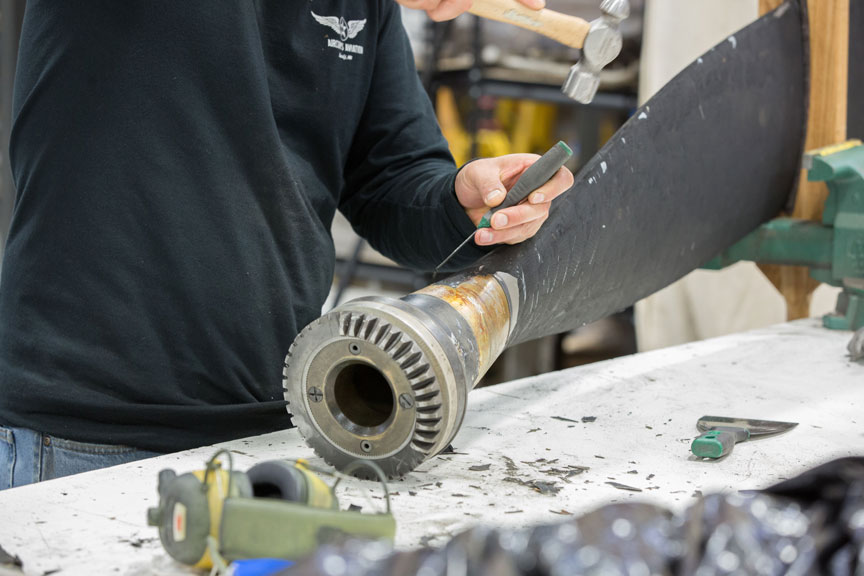
Little by little it comes off…the first blade.
One of the more tedious jobs is peeling off the nickel plating on the replacement Grumman Albatross prop blades in preparation for complete overhaul.
This has to be done extremely carefully so as not to damage the blade itself.
Since an Albatross is an amphibian, their prop blades have nickel plating to protect against water erosion. When we use the Albatross blades on a Mustang, we remove the nickel plating. It is a painstaking and long process, but since we aren’t equipped to do it electrochemically, we chip it off by hand.
This is done not only for authenticity, but because the nickel plating can split at the leading edge of the blade. If that happens, all the nickel plating needs to come off anyway. Doing it now may save downtime in the future.
Red Tail Move
As I mentioned in the introduction, an auspicious event happened on Tuesday, September 13th as the Red Tail Mustang left our restoration shop to be moved out to the airport hangar. This signals we are nearing the stage where Tuskegee Airmen will be wearing her wings once again.
She will continue to have work done on the fuselage and tail assemblies as she awaits her wings.
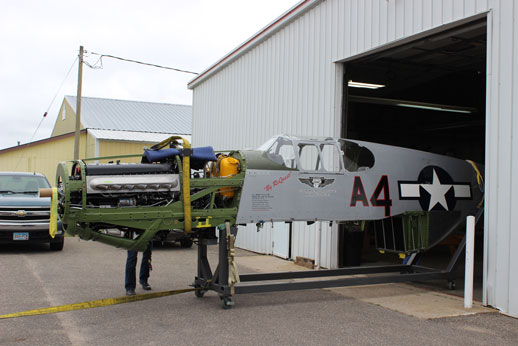
Red Tail is slowly pushed out of the shop door.
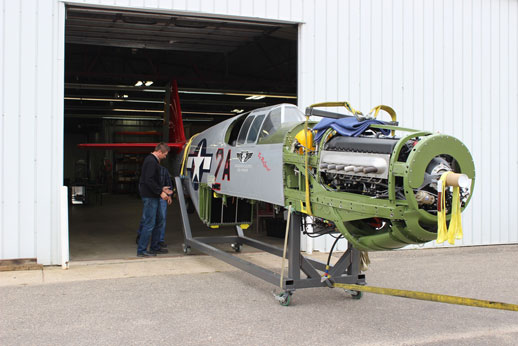
There isn’t much clearance around her horizontal stabilizer.
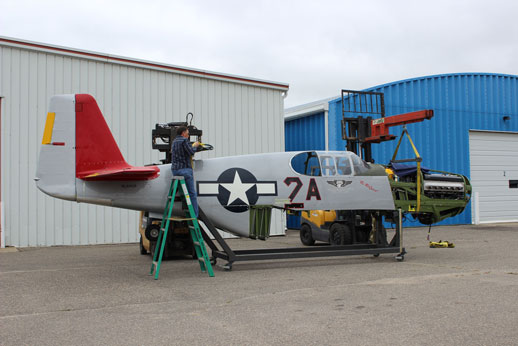
Fixing the lifting equipment. On the front, a Jib Rig is used with a strap arrangement and at the rear straps connect to a steel rod through the lifting hole.
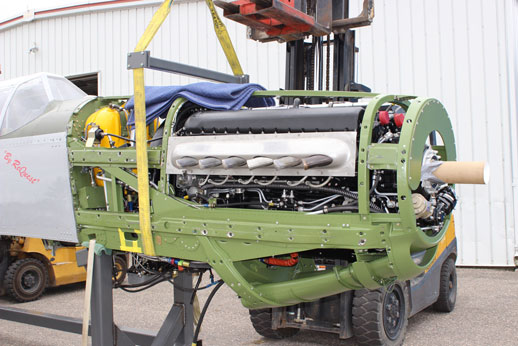
Here’s a closer view of the lifting strap set up.
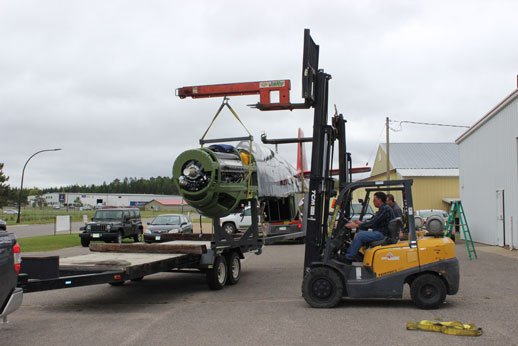
Up she goes!
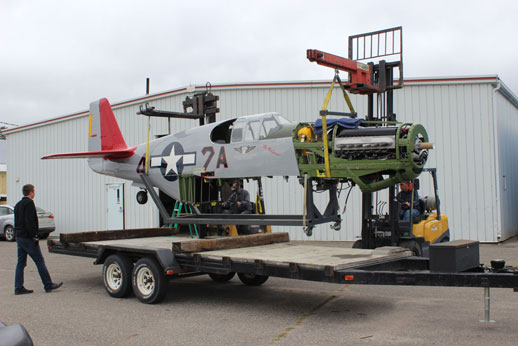
Mark and Ryan carefully align the fuselage fixture to the trailer as Erik supervises.
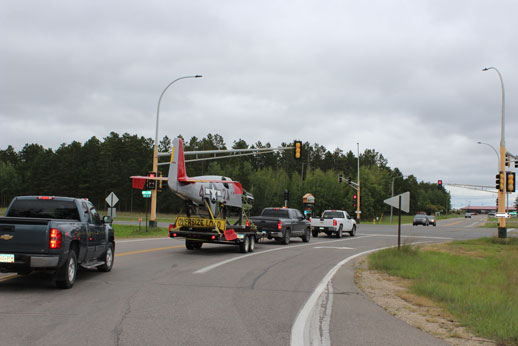
Even Mustangs have to stop for red lights, at least when they are riding rather than flying.
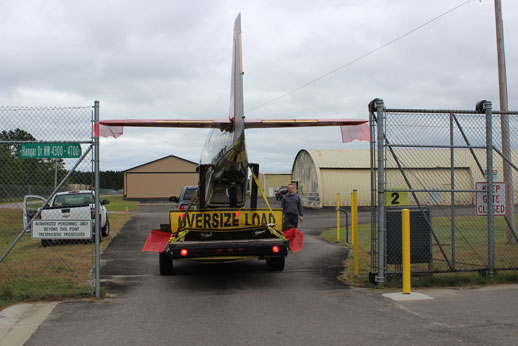
The airport gate is just as tight as the shop door.
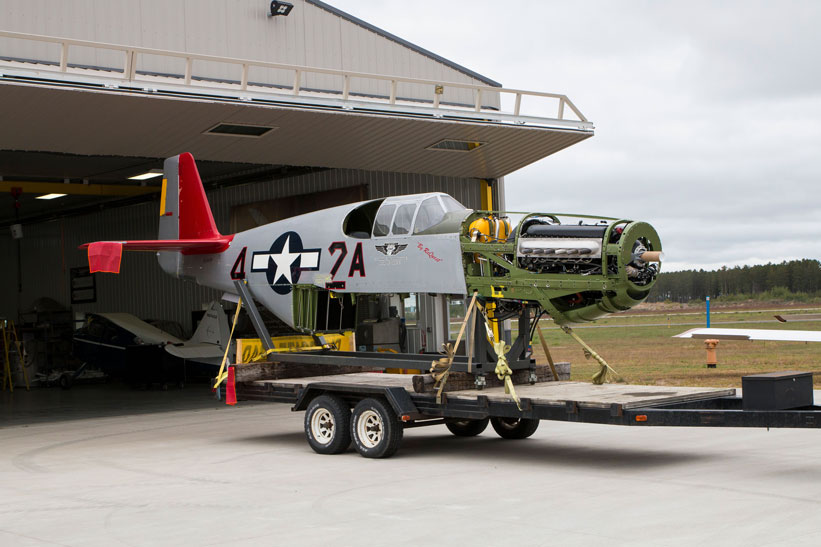
The P-51C is backed into her new temporary home.
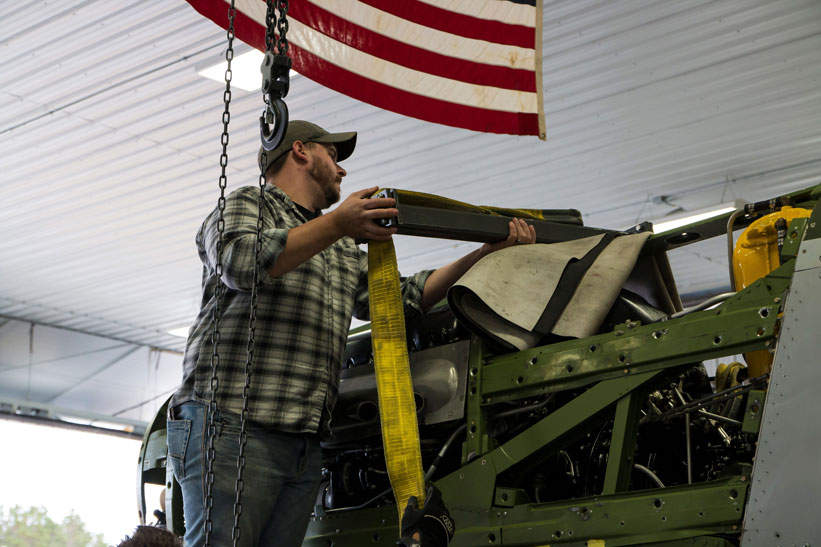
Once again, Tye hooks up the lifting equipment.
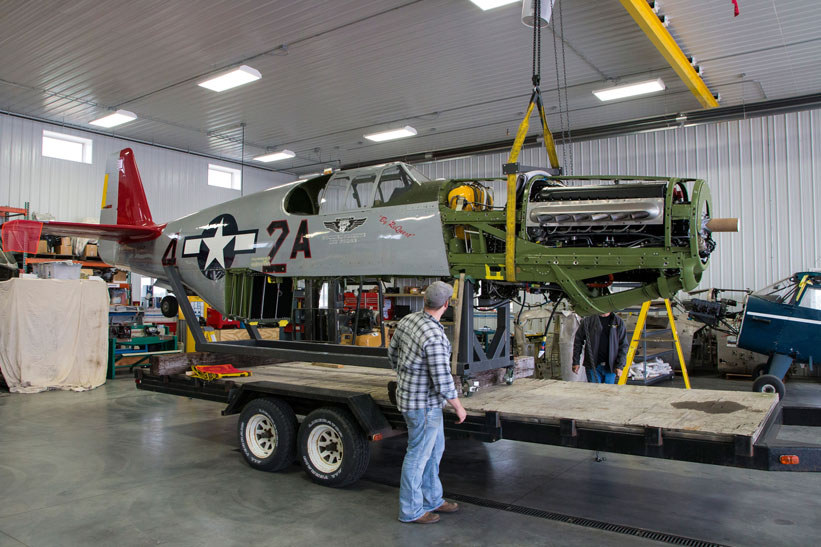
The front strap is on
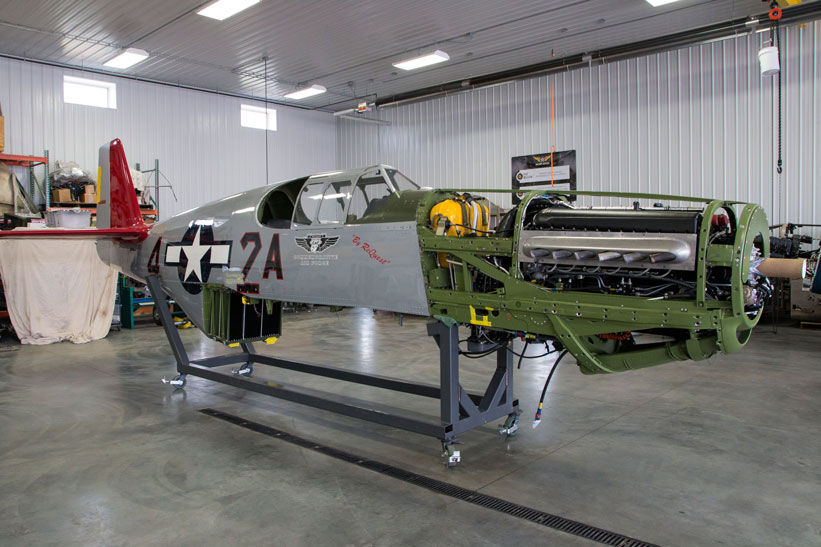
The rear strap is ready and the Red Tail will be lifted off the trailer.
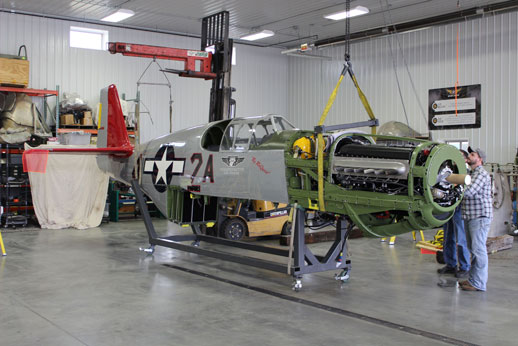
The trailer has been pulled out from under the lifted fuselage and fixture.

Tuskegee Airmen sits safely on the hangar floor, ready for the last stages of her repair.
The Red Tail’s Wing Arrives
A week later, on Tuesday September 28th, the wings arrived on another flatbed all the way from Odegaard Wings of Kindred, North Dakota.
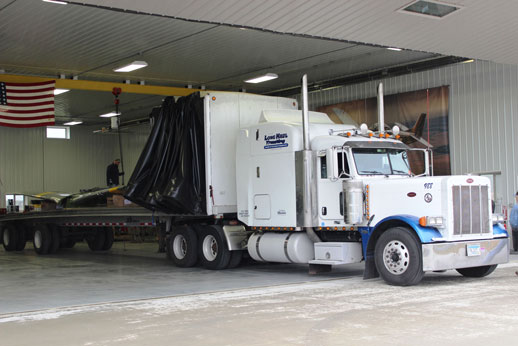
The truck backs into the shop. The wing was transported 152 miles from Odegaard Wings.
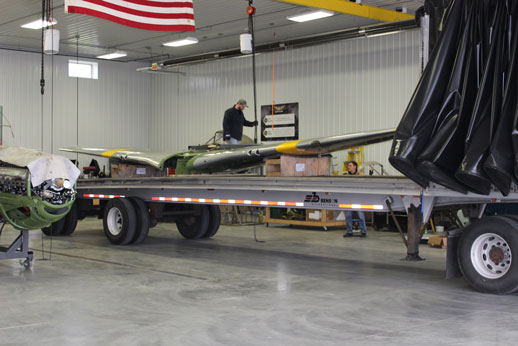
Tye connects the hoist.
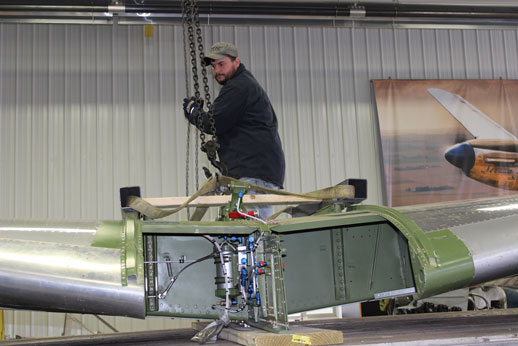
First the slack is taken up.
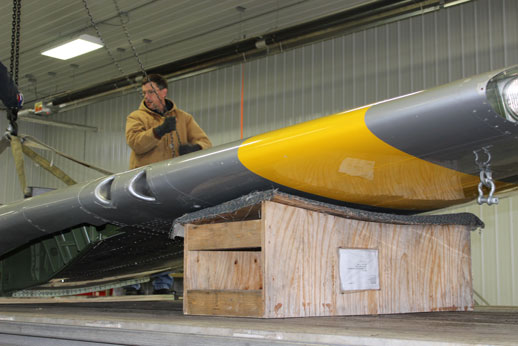
Here is a view of the shipping supports that protect the wing as it travels.
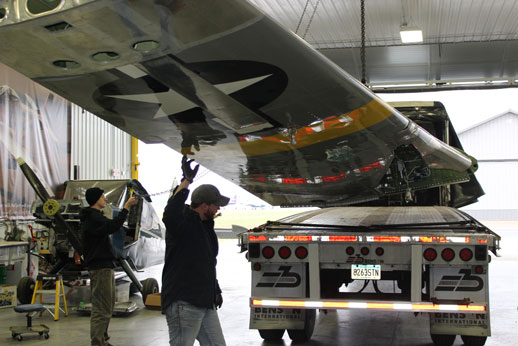
The truck drives out from under the suspended wing.
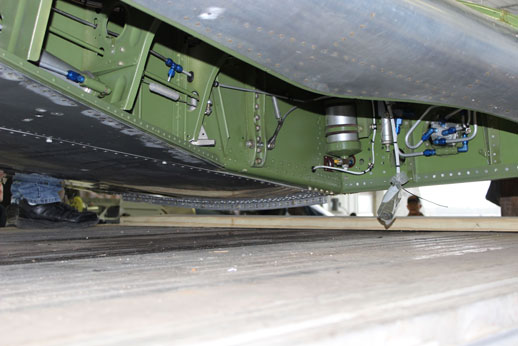
The center section is just clearing the trailer.
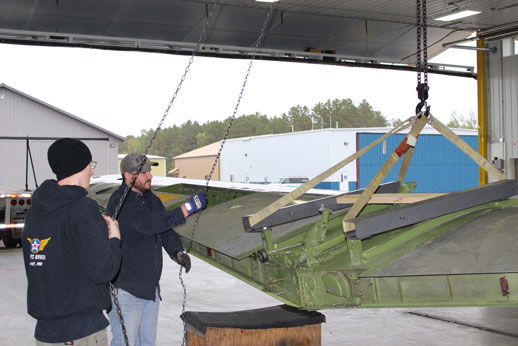
The supports have been placed prior to lowering the wing.
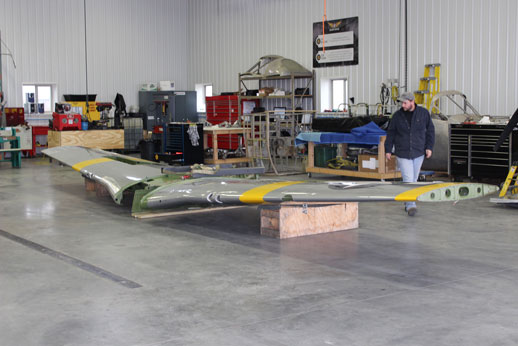
Carefully, Tye slowly lowers the wing onto the supports.
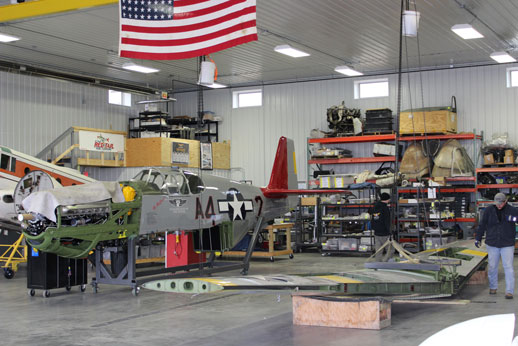
It looks right, so down it comes, right near the fuselage.

The wing is sitting on the hangar floor with the hoist disconnected.
Wing Detail
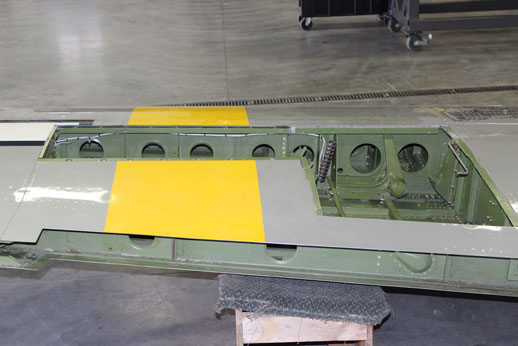
Here is a shot of the machine gun bay.

In this shot you can clearly see one of the rear gun mounts. Notice they are canted or tilted to the side.
B and C models had 4 .50 Caliber Browning M-2 machine guns mounted this way. It caused some feeding issues in heavy maneuvers. The ammo belt had to feed over the top side of the guns and make a sharp turn as it entered the loading port on the side of machine gun’s receiver. The weight of the of the ammo increased with g-forces, resulting in jams and stoppages. In the field this problem was addressed by adding B-26 booster motors to drive the belts.
The real cure came with the 6 gun P-51D and later Mustangs. The guns in those later P-51s were mounted with the sides of the M-2 receivers straight up and down rather than tilted.
Wing Detail Continued
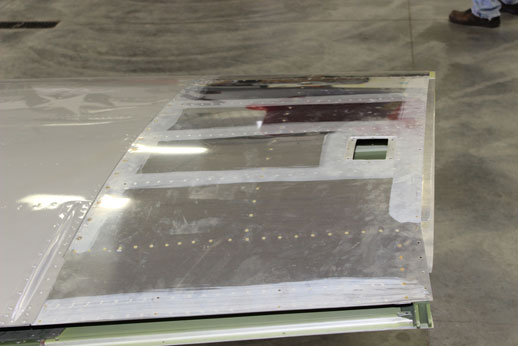
Replaced bare Alclad skin near the tip stands out from the rest of the painted wing.
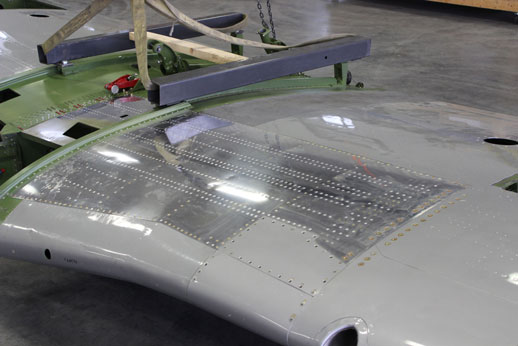
The replaced skin near the root is also very visible at this point. Now that the wing is safely in the hangar, work on installing the stress doors, gill liners and the landing gear can go forward.
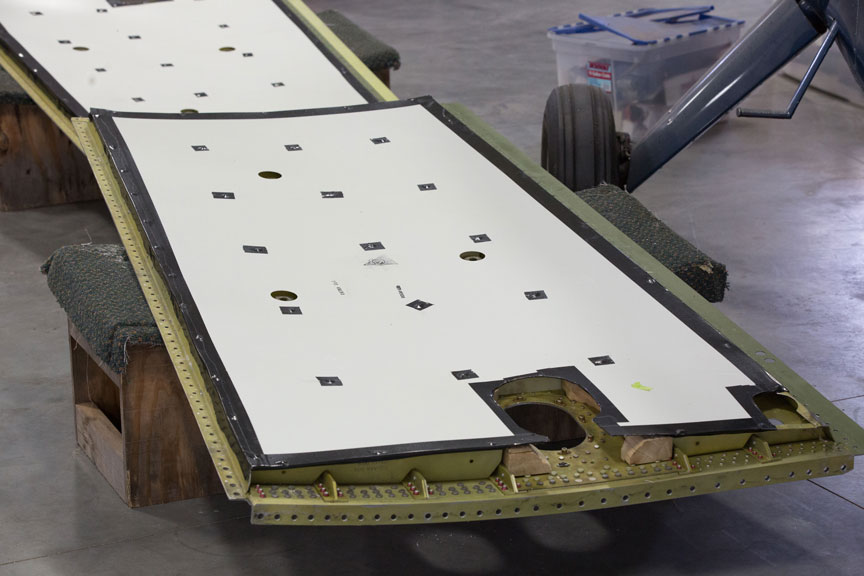
Stress doors: the white stuff is the gill liner. It protects the fuel cells from wear and damage.
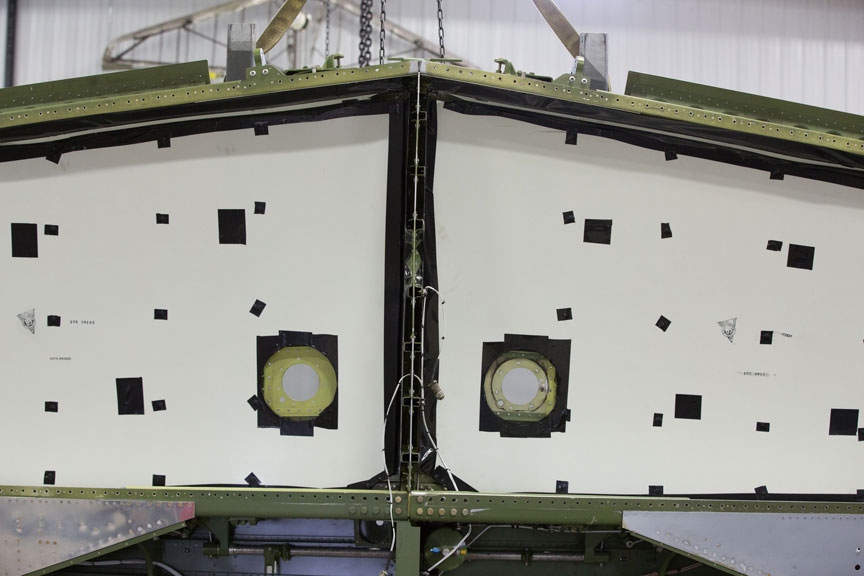
The black spots are tape that prevents any chance of a sharp edge protruding in a way that could damage the fuel cells
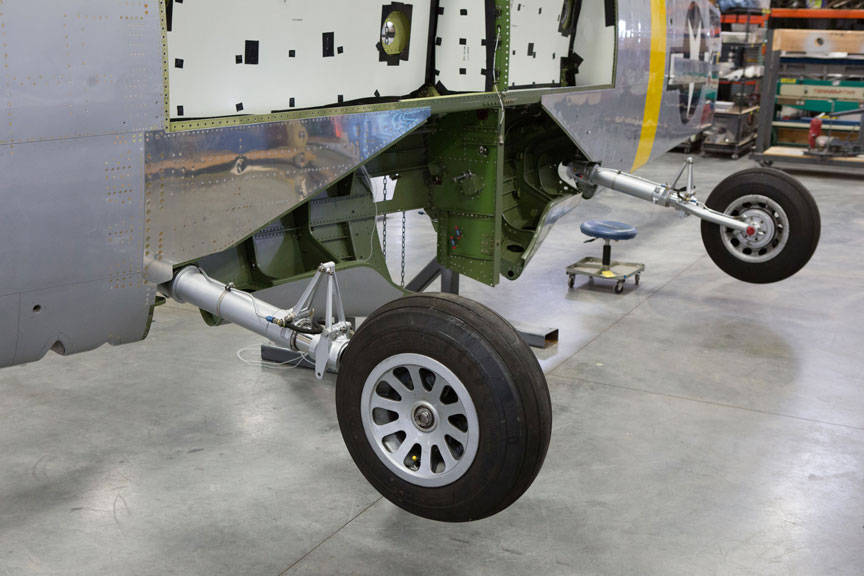
The landing gear is in place, this shot reveals details of the gear and gear bays.
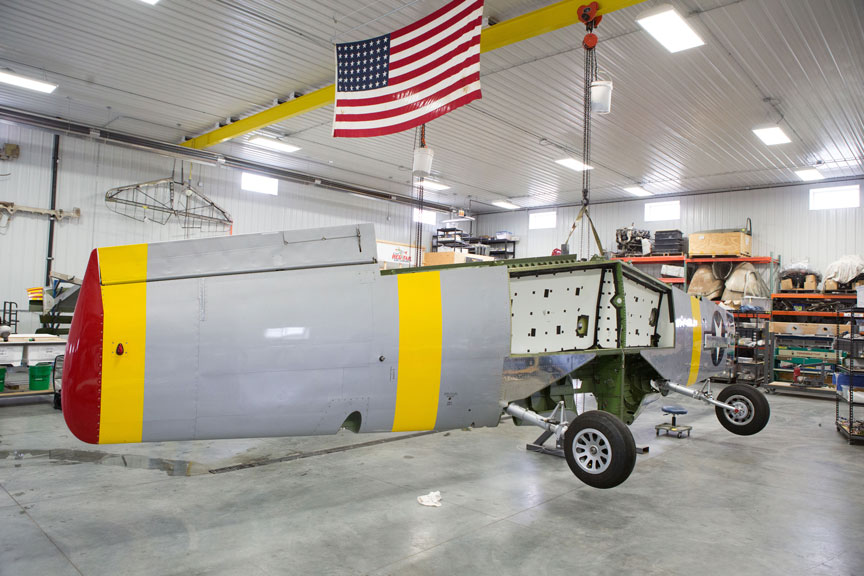
This is what the whole wing looks like with the gear installed.
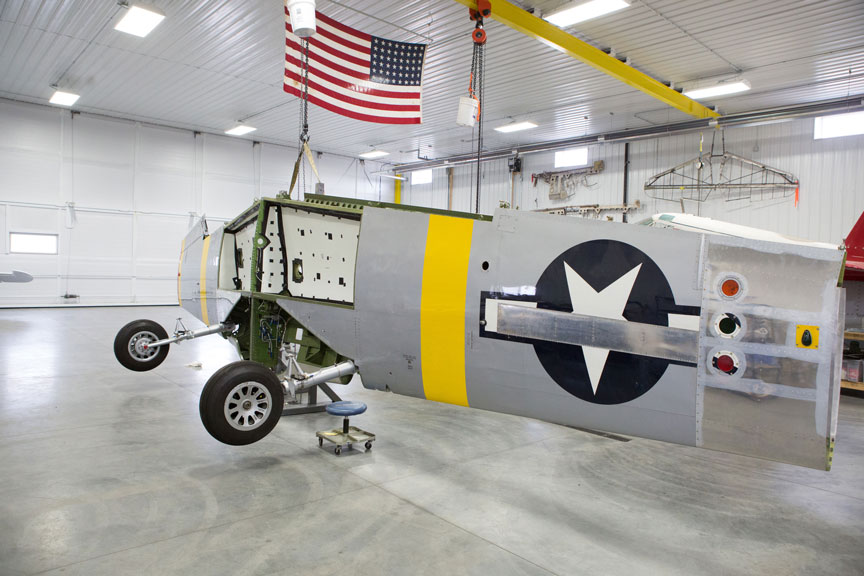
A view from the underside of the right wing shows the replaced skin panels clearly.
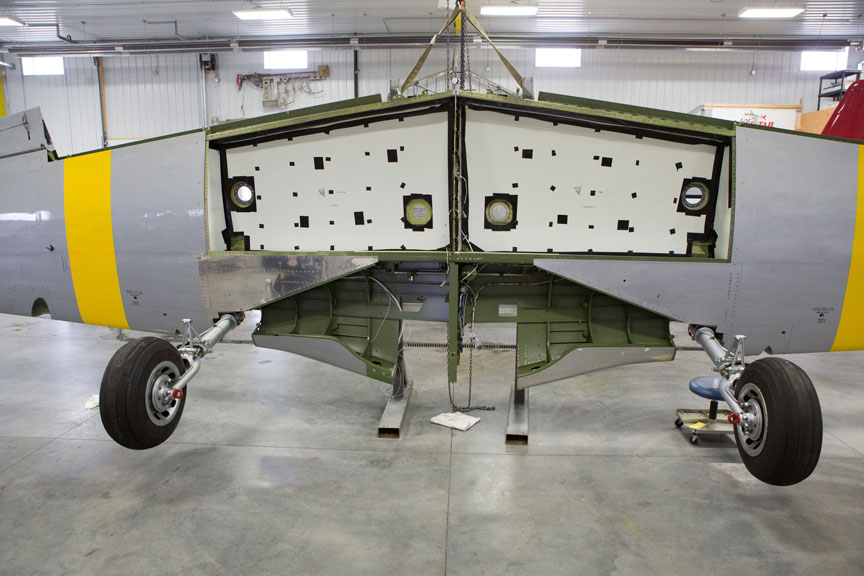
The location of the fuel cell bays under the wing is apparent here.
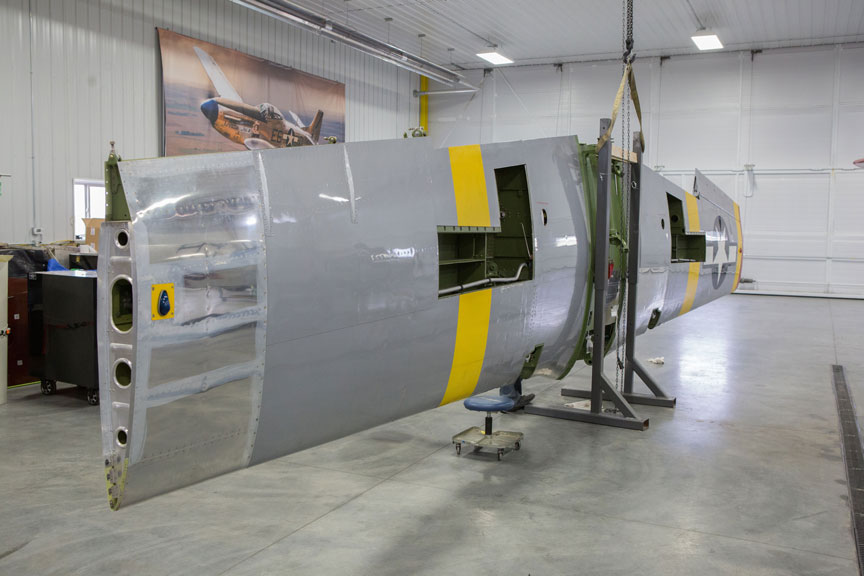
Top view of the wing mounted in the fixture that holds it leading edge down to make work easier as the gear and stress doors are fitted.
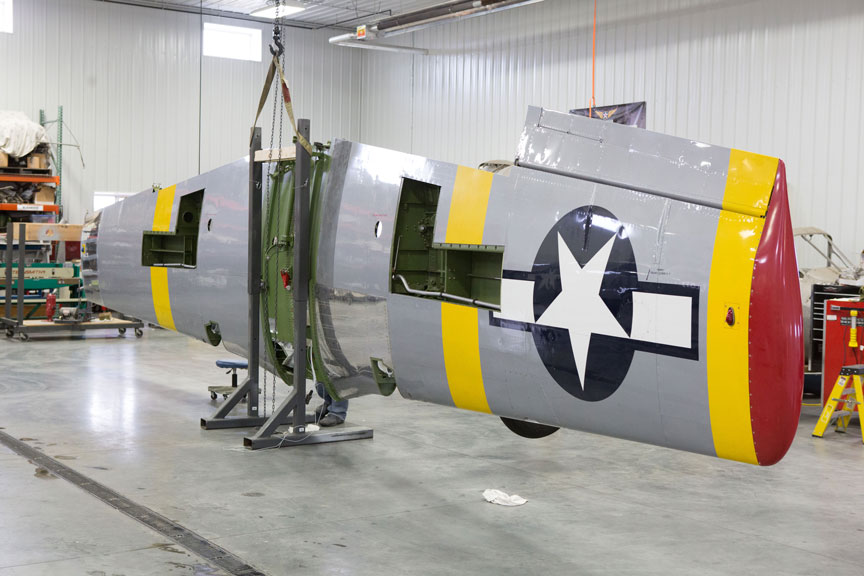
Top view of the wing in the fixture.
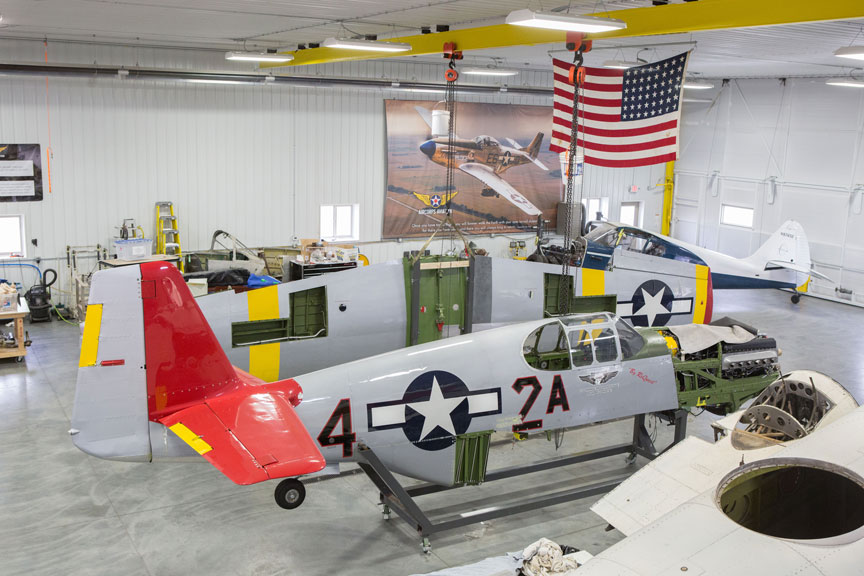
The wing and fuselage are nearly ready to be joined.
Wing Reinstallation
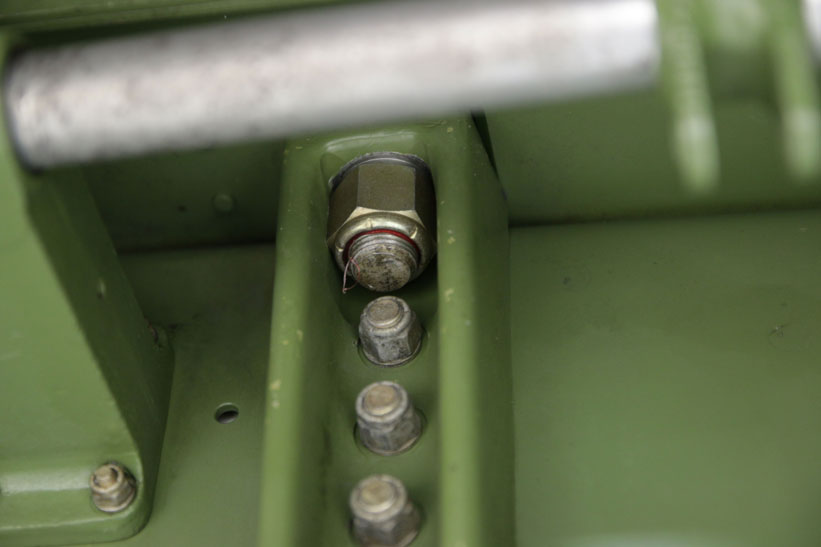
A large nut is just visible from the side in the hole in this rear wing attachment fitting. That nut is one of four that tighten onto the four bolts that hold the wing on. Only four bolts hold the engine and mounts to the firewall and four hold the wings on!
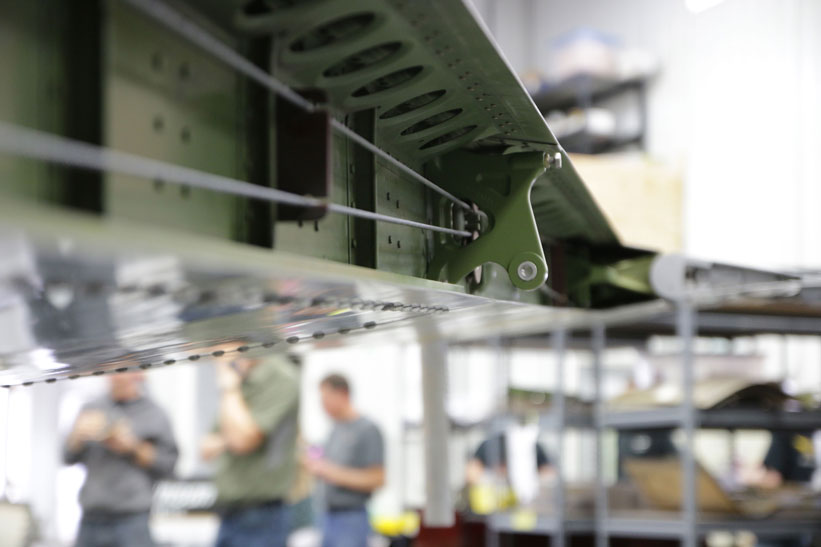
In this image, the cables that drive the ailerons are visible along the back side of the rear spar.
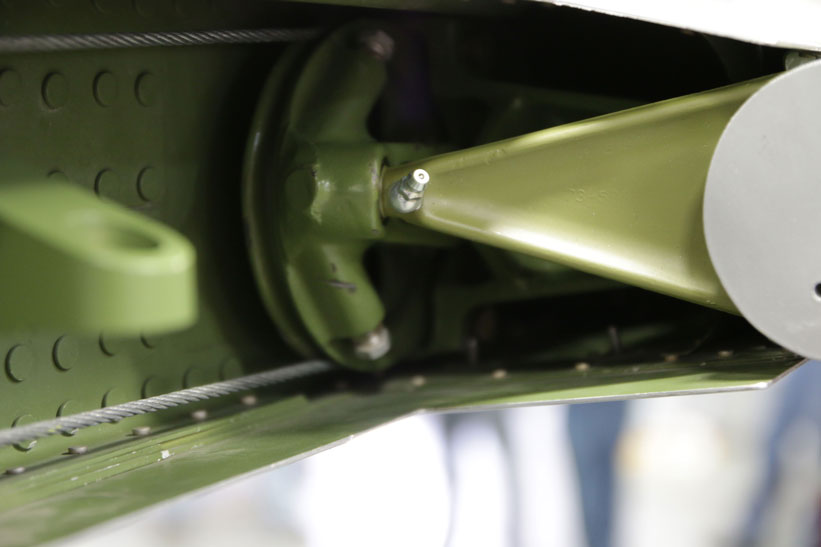
This is the aileron end of the aileron control system.
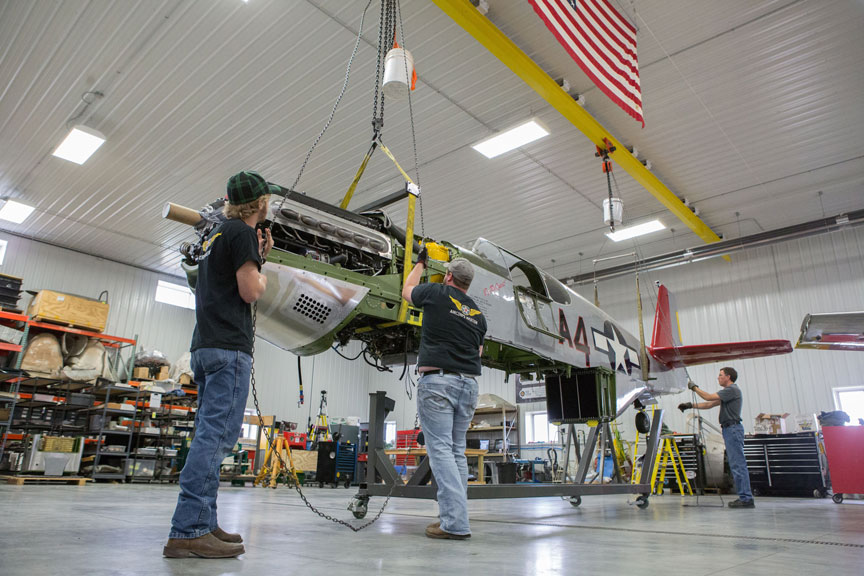
As the pulley is turned by the cables, the lighter colored aileron horn is driven up or down, depending on the rotational direction.
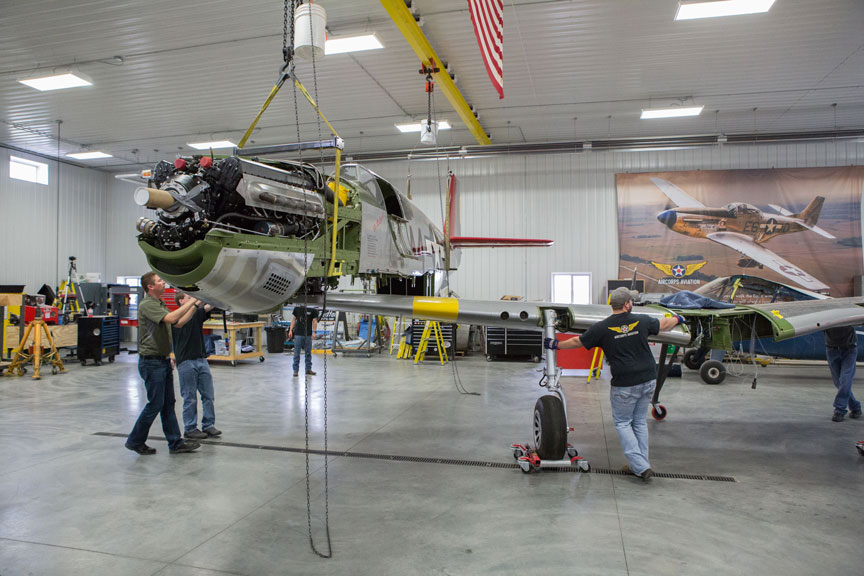
The fuselage is hoisted up from its fixture.
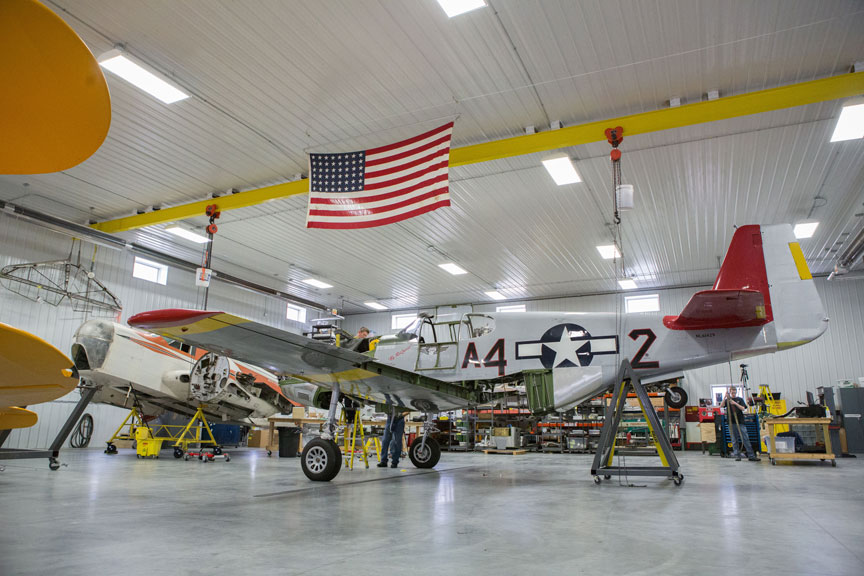
The wing is moved under the fuselage.
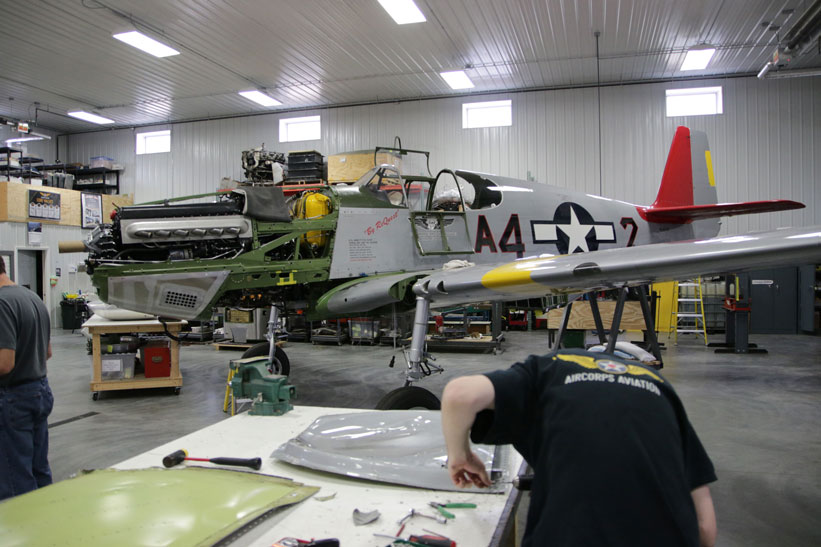
The wing is on!
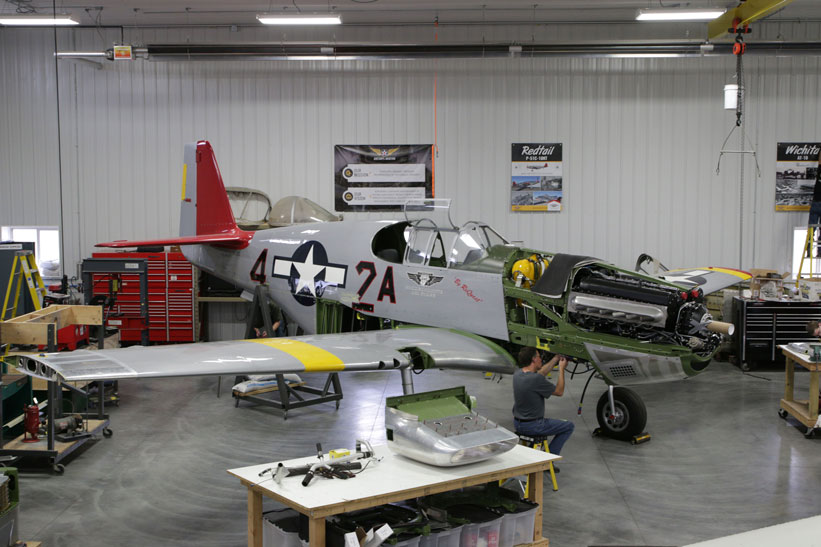
The P-51C Red Tail is looking like a Mustang with her wings on, sitting on her main gear.
